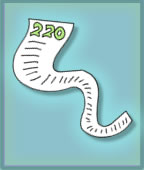 To succeed in school, your child needs to be able to read 220 vitally important, high-frequency words---words like I, and, go, what, are, etc., which are "connecting" words that give sentences their meaning.
To succeed in school, your child needs to be able to read 220 vitally important, high-frequency words---words like I, and, go, what, are, etc., which are "connecting" words that give sentences their meaning.
These 220 words were identified by Edward William Dolch PhD. in 1948. Dr. Dolch’s theory was that if children could read these words rapidly and without conscious effort, they would be well on their way to becoming good readers
For example, the blue words in the following sentence are all “Dolch” words:
The dog ran after the cat, but the cat got away.
Here is the percent of Dolch words in some well-known children’s books:
- 87% - Green Eggs and Ham by Dr. Seuss
- 78% - Go, Dog. Go! by P.D. Eastman
- 78% - Are You My Mother? by P.D. Eastman
- 82% - I Want to Be Somebody New! by Robert Lopshire
- 83% - A Fly Went By! by Mike McClintock
- 78% - The Cat in the Hat by Dr. Seuss
- 81% - The Cat in the Hat Comes Back by Dr. Seuss
- 75% - One fish two fish red fish blue fish by Dr. Seuss
(List compiled by - and available at - www.picturemereading.com)
And not just children's books. Dolch words constitute 50--80% of the words in ALL materials written in the English language. For instance, 62% of the words in the Gettysburg Address are Dolch words.
Many schools in the United States recognize the Dolch high-frequency word lists as a VITAL step in creating a good reader. However, Dolch word lists are often presented as SIGHT-WORDS (words to be taught with memorization, without regard to the number of syllables or phonic content). As a result, words like yellow, where, said, make, three and little are among the very first sight-words taught to small children!
We think that is a little bit steep. Therefore, we took it upon ourselves to rearrange the Dolch word list according to the phonics principles that the words follow or break. As a result, the simpler Dolch words (such as big, not, let, ran, on, is, it, etc.) are among the first Dolch words taught in our program.
Unfortunately, some phonics programs ignore these words, possibly because almost a third of the Dolch words violate phonics rules—words like where, there, are, come, was, etc. But not Progressive Phonics. We built our program around the Dolch words, and the words are prioritized in each of our books.
By the end of our phonics program, a child will not only know every single word on the Dolch list, but how to say it, spell it and what it means in context.
And that pays off in terms of literacy and fluency.
We have 376 guests and no members online